If you’ve overheard your managers and tech teams tossing around terms like “DevOps,” “automation,” and “CI/CD” on the production floor and wondered what it’s all about, you’re in the right place.
DevOps, a combination of “development” and “operations,” is a collaborative approach that unites software developers and IT operations teams. This synergy aims to shorten the development lifecycle while delivering high-quality software continuously.
A pivotal element in this methodology is DevOps automation. By automating repetitive tasks, teams can enhance efficiency, reduce errors, and focus more on innovation.
The adoption of DevOps practices is on the rise. According to a report, 83% of IT decision-makers have implemented DevOps practices to unlock higher business value.
Curious about how DevOps automation can transform your development process for the better? Let’s get started!
What is DevOps Automation?
DevOps automation is the process of using technology to automate manual tasks in the software development lifecycle. This includes everything from coding and testing to deployment and monitoring.
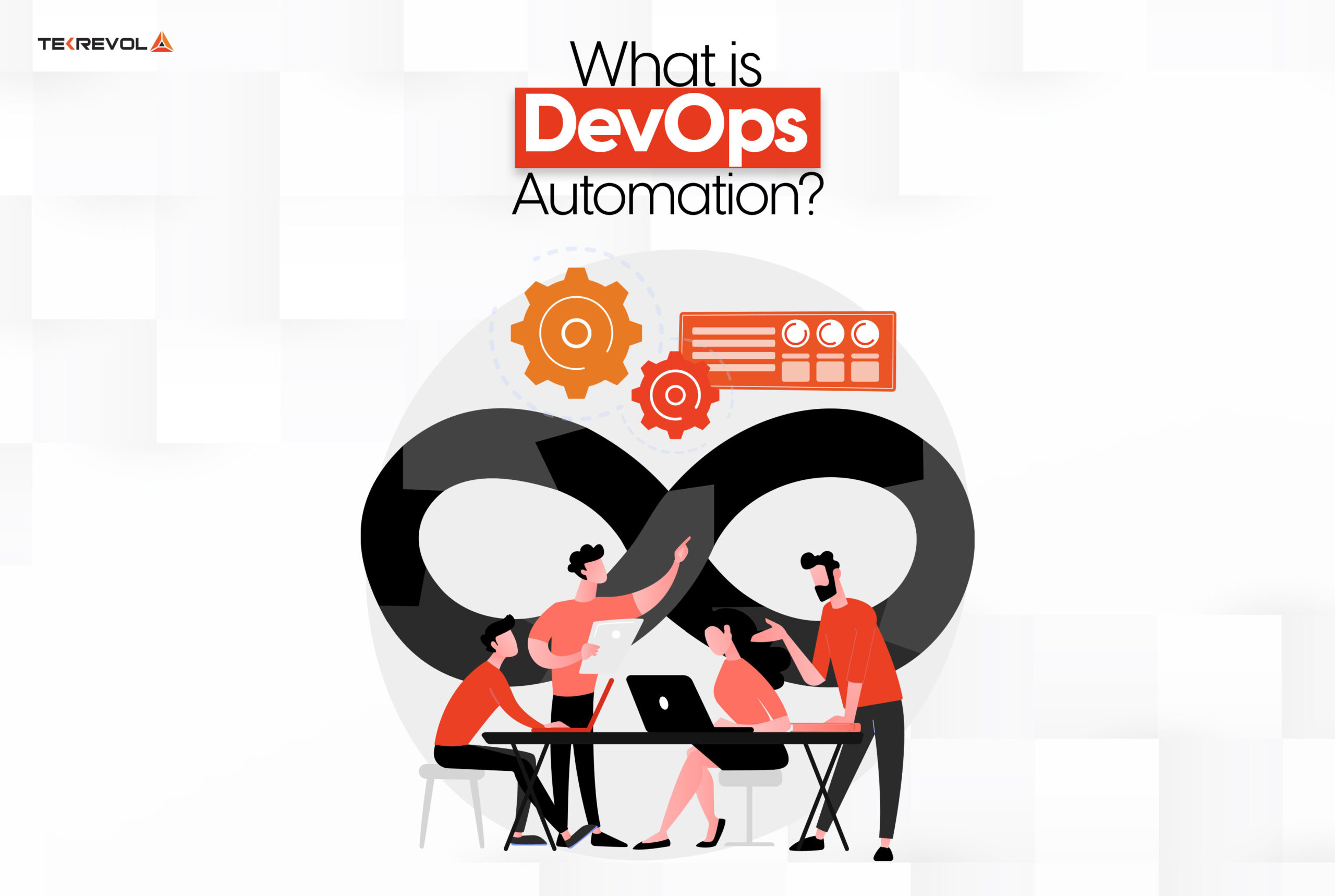
Automation is crucial in DevOps because it streamlines processes, reduces human error, and improves overall efficiency. For instance, automated testing can quickly identify bugs in code, allowing developers to fix issues before they reach production. This not only saves time but also enhances the quality of the software being developed.
In DevOps, automation promotes alignment between development and operations teams. This leads to faster software delivery and higher reliability by minimizing manual intervention. Key components of DevOps automation include
- Continuous Integration and Delivery (CI/CD)
- Infrastructure as Code (IaC)
- Automated Testing.
Together, they create a responsive system that adapts quickly to changes.
When organizations implement DevOps automation effectively, they can reduce their reliance on large teams for projects. This means fewer resources are needed, which ultimately boosts productivity and creates a more dynamic development cycle.
Benefits of DevOps Automation
Did you know that DevOps teams deploy 106 times faster than low-performing teams. This impressive statistic highlights just how transformative automation can be in software development.
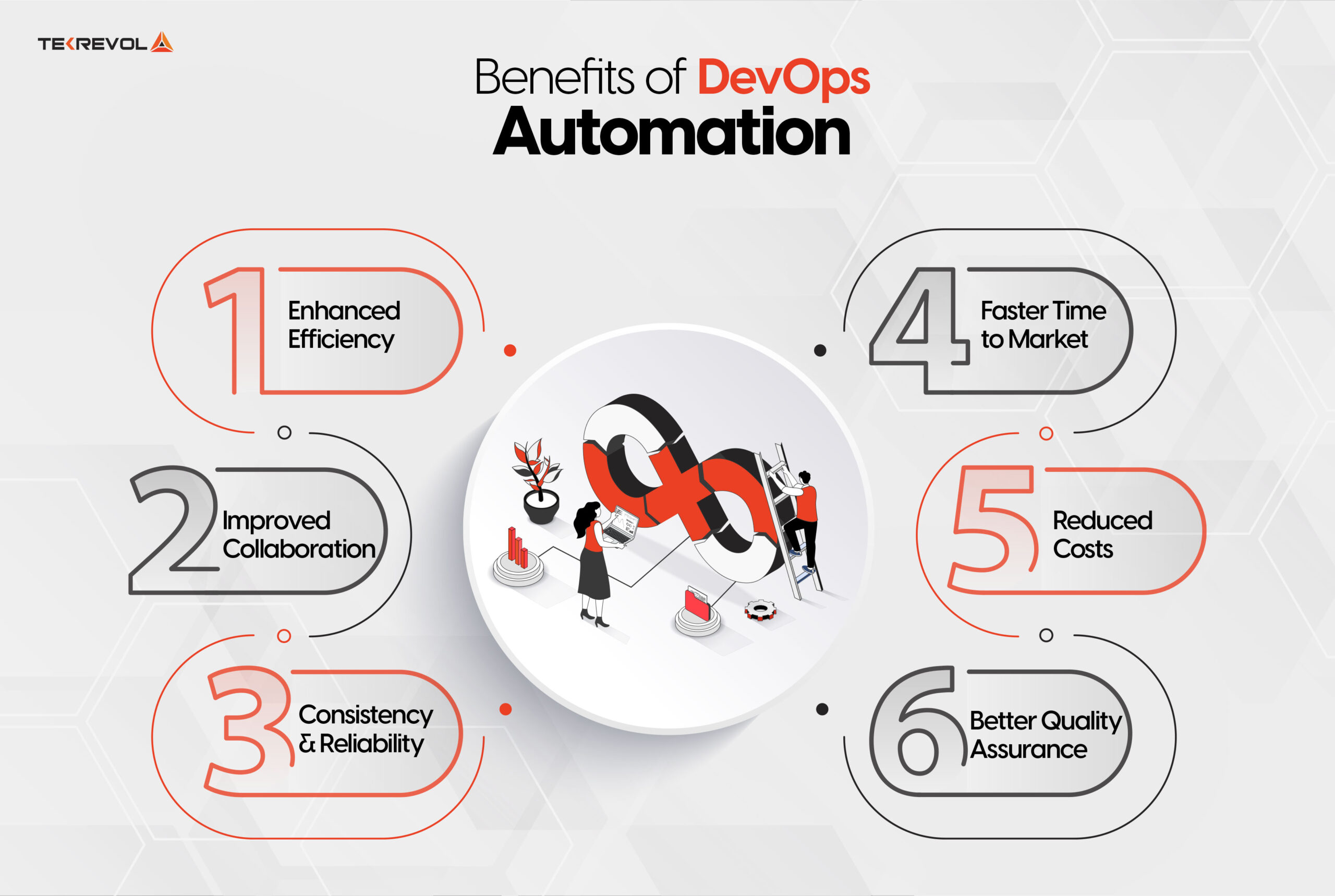
Here are some key benefits of DevOps automation:
Enhanced Efficiency
Automation streamlines the software development lifecycle. By eliminating repetitive tasks, teams can focus on more complex and valuable work, improving overall product quality.
Improved Collaboration
With automated tools, development, operations, and quality assurance teams can work together more seamlessly. This reduces friction and fosters a collaborative work environment.
Consistency and Reliability
Automation ensures that processes are executed uniformly. This consistency minimizes human errors, leading to more reliable software builds, testing, and deployments.
Faster Time to Market
Automation greatly accelerates the process from development to deployment. It enables the swift response of organizations to market requirements while outpacing competitors.
Reduced Costs
By automating routine tasks, organizations can cut down on manual labor hours, leading to lower project costs. The improved accuracy and reduced downtime also contribute to cost efficiency.
Better Quality Assurance
Automated testing allows for continuous integration and delivery. This means bugs are caught earlier, resulting in higher-quality software and a smoother user experience.
Which DevOps Processes Do You Need to Automate?
The short answer is everything. In practice, however, it is best to focus on specific processes that bring the most important value. Automation in DevOps reduces manual workload and improves accuracy for teams, accelerating the overall lifecycle of developing software.
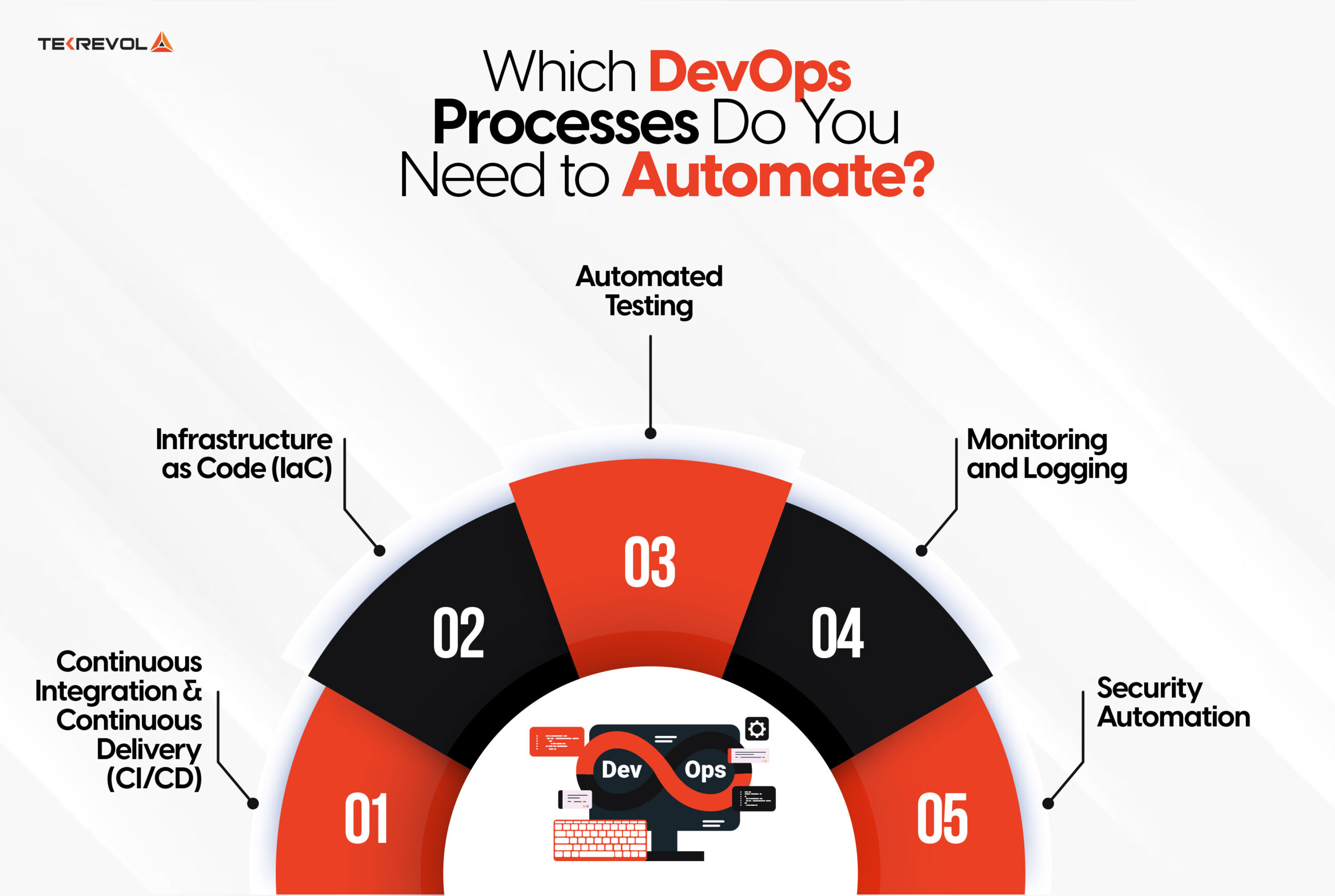
Some of the key DevOps processes that can be streamlined with automation are:
Continuous Integration and Continuous Delivery (CI/CD)
CI/CD is fundamental to DevOps automation. Continuous Integration sees code changes very frequently so that teams can find integration errors soon. It helps ensure that changes can be delivered to production at any time, making releases easier.
Popular Tools:
- Jenkins
- GitLab CI/CD
- CircleCI
- AWS CodePipeline
Infrastructure as Code (IaC)
IaC automates the management of infrastructure through machine-readable definition files. This approach allows teams to provision and manage environments consistently and efficiently, eliminating the “it works on my machine” problem.
Popular Tools:
- Terraform
- AWS CloudFormation
- Ansible
- Pulumi
Automated Testing
Automated testing is crucial for maintaining code quality. By integrating automated tests into the CI/CD pipeline, teams can catch bugs early and ensure that every change meets quality standards before deployment.
Popular Tools:
- Selenium
- JUnit
- TestNG
- Postman (for API testing)
Monitoring and Logging
Automated monitoring tools monitor application performance and health. They set up alerts based on predefined conditions so that teams address problems before they can affect users. Logging automation helps quickly identify problems by analyzing logs from many sources.
Popular Tools:
- Prometheus
- Grafana
- ELK Stack (Elasticsearch, Logstash, Kibana)
- Datadog
Security Automation
Integrate security into your automation process. Automated security testing picks security vulnerabilities up at development time and ensures compliance monitoring to applications at all times.
Popular Tools:
- Snyk
- OWASP ZAP
- Aqua Security
- Checkmarx
Best Practices for DevOps Pipeline Automation
Implementing best practices in DevOps is essential for simplifying the software management lifecycle and improving operational efficiency. Organizations that adopt these practices can see a significant reduction in deployment times, with some reporting up to a 200% faster release cycle.
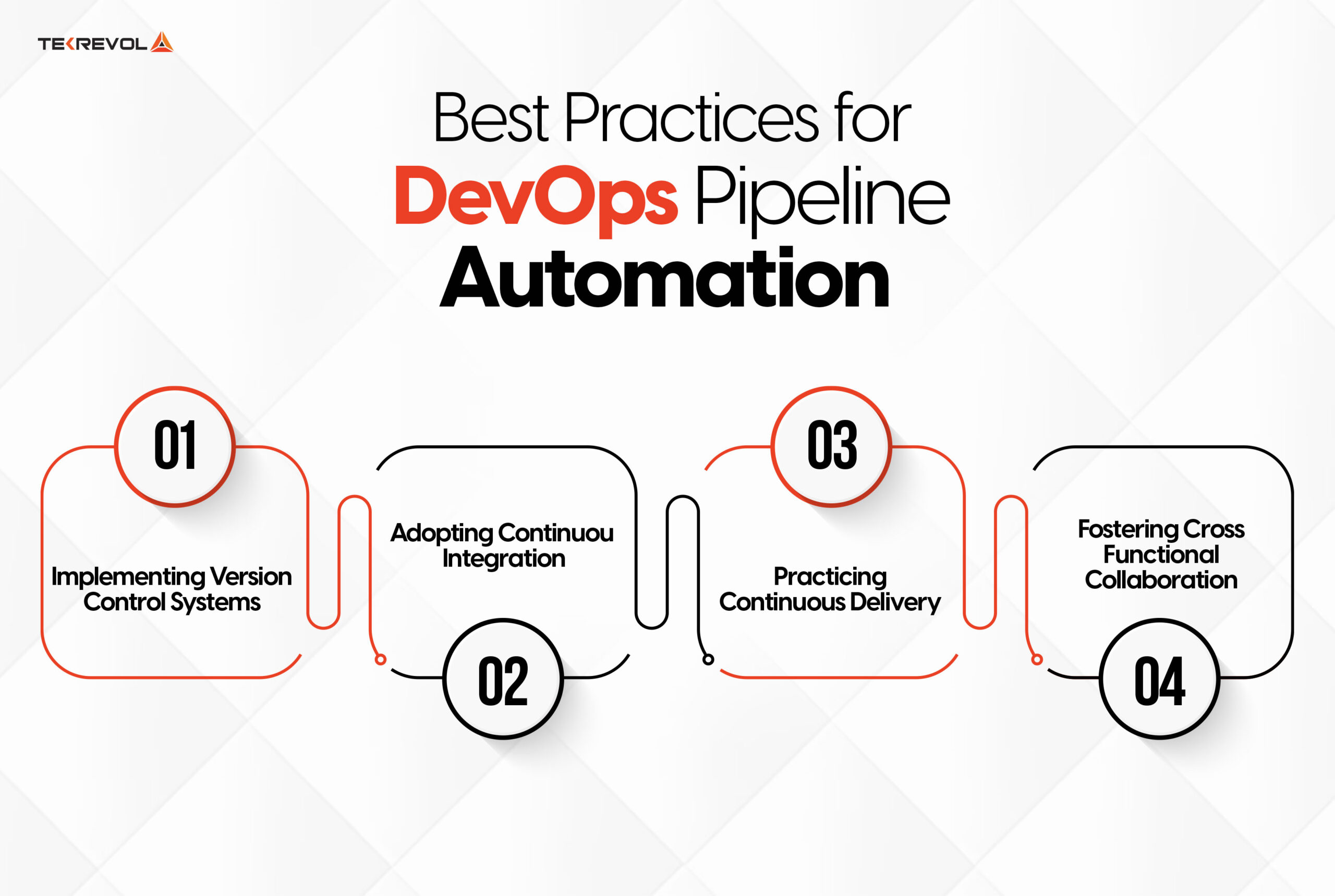
Here are key best practices to enhance your DevOps pipeline automation:
Implementing Version Control Systems
Version control is very important in handling code changes. It allows teams to track modifications, collaborate seamlessly, and revert to previous versions if necessary. This way, all changes are documented using version control systems such as Git, which enhances accountability and reduces conflicts.
Adopting Continuous Integration
Continuous Integration (CI) pipeline is critical to integrating code changes frequently. The best practices are automation of the build process, running tests on every commit, and ensuring that the main branch is always in a deployable state. This approach helps to catch integration issues early and instils a culture of rapid feedback.
Best practices for CI include:
- Automating the build process using tools like Jenkins or Travis CI.
- Running automated tests with every code change to catch issues early.
- Keeping the main branch stable by implementing pull requests and code reviews.
Practicing Continuous Delivery
Continuous Delivery (CD) ensures that code is always ready for deployment. Strategies for achieving this include automating the deployment process, maintaining a staging environment that mirrors production, and implementing automated testing to validate every change.
Strategies for effective CD include:
- Automating the deployment process using tools like AWS CodePipeline or GitLab CI/CD.
- Implementing automated rollback mechanisms in case of deployment failures.
- Maintaining a staging environment that mirrors production for thorough testing before release.
Fostering Cross-Functional Collaboration
Encouraging collaboration between development, operations, and other stakeholders is essential for DevOps success. Breaking down organisational silos and promoting open communication helps create a shared sense of responsibility for outcomes.
Teams can work more effectively together because of cross-functional teams. This leads to better solving of problems and innovation.
Practices to enhance collaboration include:
- Utilizing shared tools like Slack or Microsoft Teams for real-time communications.
- Having regular stand-up meetings discussing progress and roadblocks.
- Implement a shared ownership culture where all members have a stake in ensuring the success of your project.
Popular DevOps Automation Tools
With the rise in organizations embracing DevOps practices, numerous powerful automation tools are available to make all phases of software development and deployment much easier. Below are some of the major tools in question that are defining the scope:
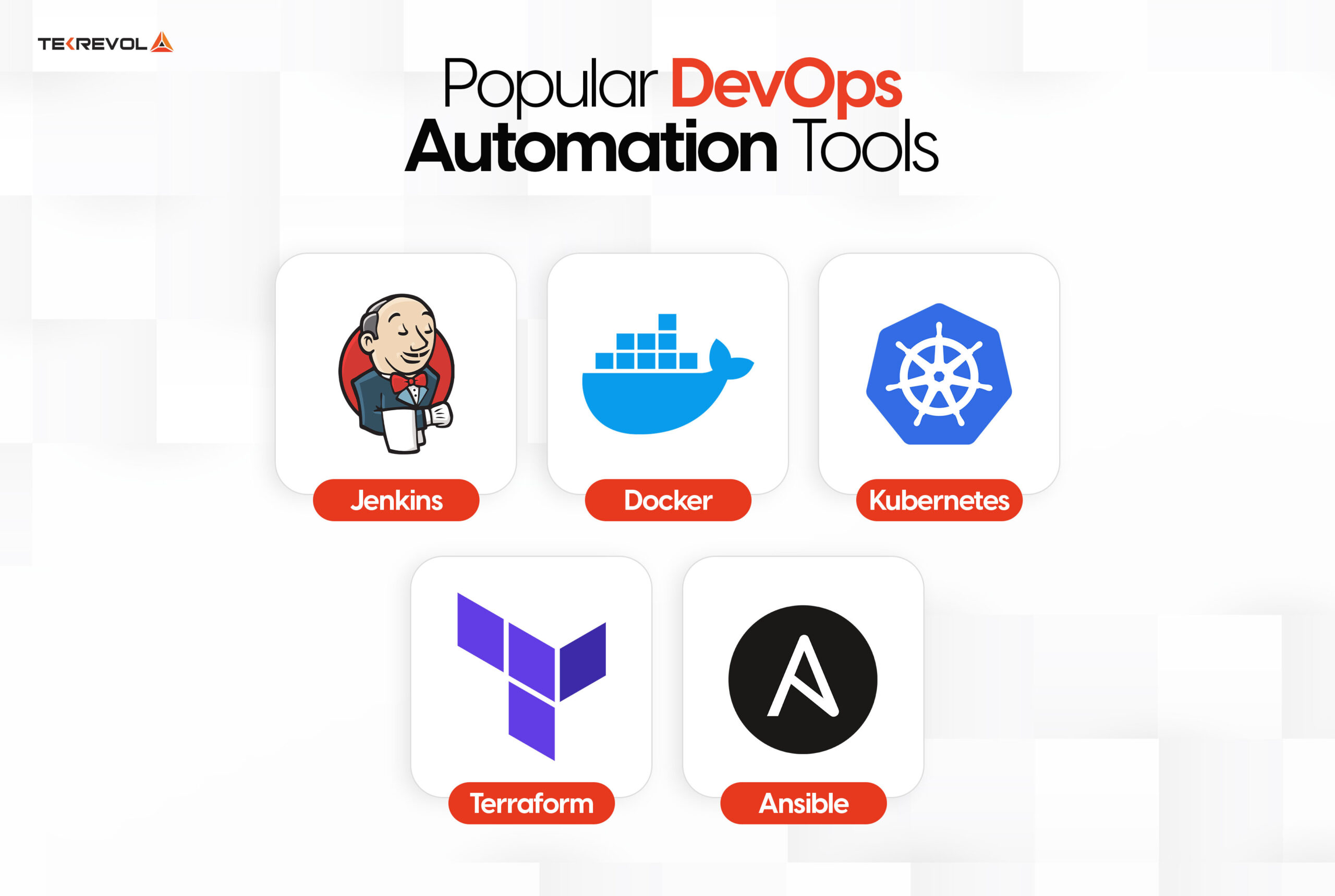
Jenkins
Jenkins is one of the most popular open source CI/CD tools that automates building, testing, and deployment of code changes. Rich ecosystem of plugins Its wide support to integration with nearly any tool in use for software development is a cornerstone of many DevOps pipelines.
Docker
Docker simplifies application development, deployment, and management inside containers. This ensures consistency in development, test, and production environments, where deployments are more predictable and reliable with Docker.
Kubernetes
Kubernetes is a powerful container orchestration platform that automates the deployment, scaling, and management of containerized applications. It allows teams to efficiently manage complex applications in production, ensuring high availability and resource optimization.
Terraform
Terraform is an IaC tool with the provision to make teams utilize the infrastructure through code provision and management. Its declarative language expresses the desired infrastructure state and continuously applies changes to ensure consistency among environments.
Ansible
Ansible provides automation for simplification in the process of configuration management and application deployment. It presents an opportunity for teams to simplify complex tasks through easy YAML-based playbooks, making it a valuable tool in managing servers and applications.
Implementing DevOps Automation: A Step-by-Step Guide
Implementing DevOps automation effectively requires a structured approach to ensure that all aspects of the process are covered. By following a step-by-step guide, organizations can streamline their workflows and maximize the benefits of automation.

Here’s how to get started:
Assessing Organizational Needs
Start by reviewing existing workflows to identify areas of repetitive work and where it is ripe for automation. This requires input from your team members across departments to understand challenges and needs. What you’re doing here is understanding where the maximum impact can be drawn with automation, thus allowing for effective prioritization of efforts.
Selecting Appropriate Tools
The right toolset would be a key determinant of successful automation. Options include Jenkins, Continuous Integration/Continuous Delivery (CI/CD), Docker, containerization, and Terraform, Infrastructure as Code (IaC). These tools need to be aligned with your infrastructure and will help increase productivity while providing operational consistency.
Gradual Automation of Processes
Start with easier tasks and show early wins. Incremental progress breeds confidence from within and proves the value of automation. The more precise your strategy becomes, start tackling more intricate workflows, giving teams scope to get used to and learn.
Encouraging Cross-Functional Collaboration
Maintain close collaboration across development, operations, and other stakeholders to ensure alignment during the automation process. Encourage open communication and shared responsibilities, so everyone understands their role in achieving successful automation outcomes. This collaborative atmosphere helps create a cohesive strategy that benefits the entire organization.
Continuous Monitoring and Improvement
Monitor automated processes regularly and collect feedback to detect bottlenecks or areas for improvement. Regular reviews of the performance and optimization of workflows should take place as your organization grows. This will ensure that your automation strategy is efficient and constantly adaptable to the needs.
By following these steps, organizations will be able to implement DevOps automation effectively, thus achieving better efficiency, fewer errors, and faster software delivery.
How DevOps Automation Enhances Mobile App Development in Toronto
Toronto is becoming the mobile application development center quickly because more than 1,500+ tech companies have moved their operations to the region. In the last five years, the city has seen a sharp increase of 30% in mobile app development jobs as demand for innovation in digital solutions has surged.
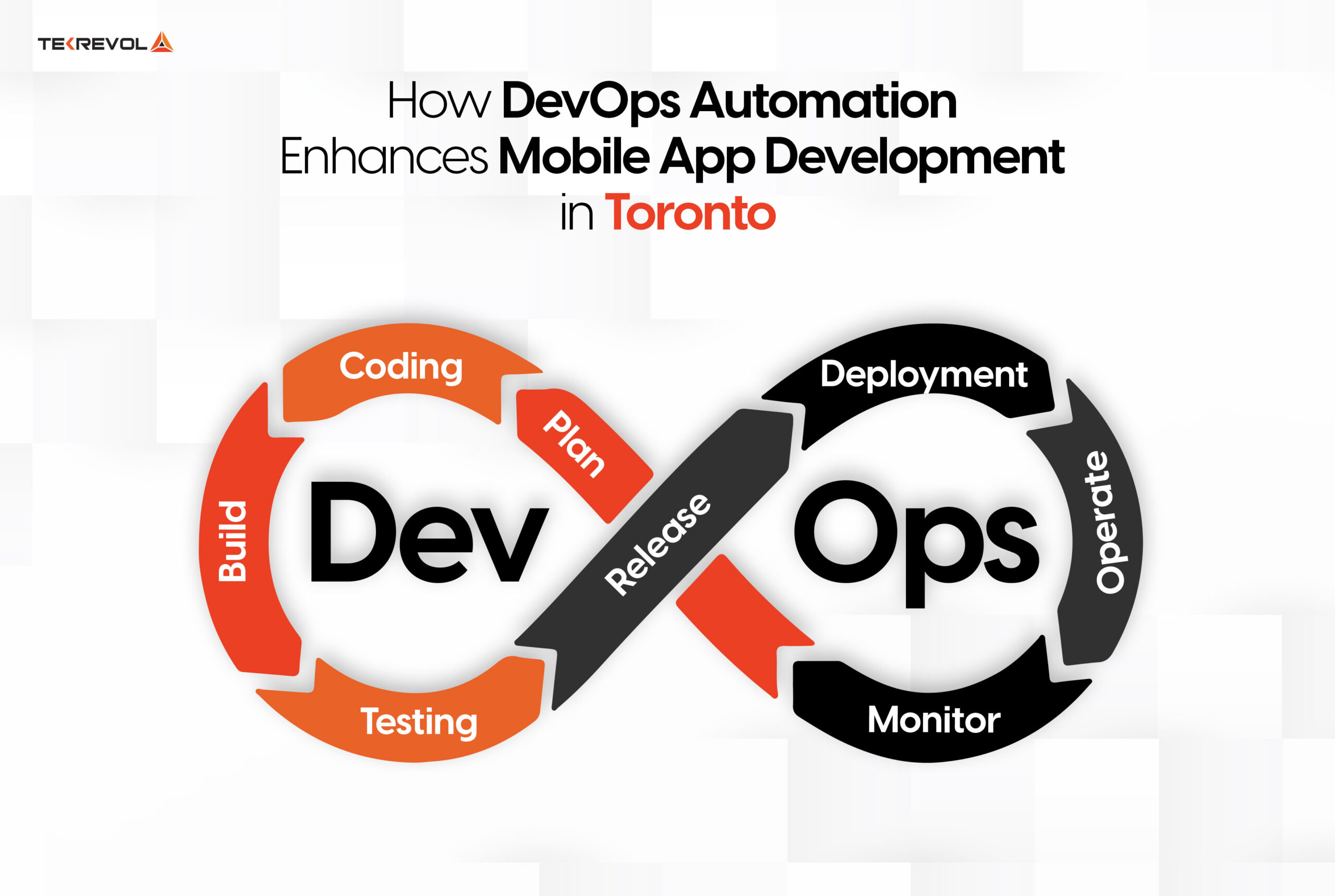
When such an ecosystem is growing, there is a huge need to adopt DevOps automation to follow market requirements for developers.
This kind of automation through DevOps highly impacts the Toronto mobile app development landscape, reducing the release time, improving app quality, and enabling teams to meet increased demands for new features.
For example, TekRevol, a leading mobile app development company in Toronto uses Jenkins for CI/CD and Docker for containerization. Such a combination allows for streamlining the development pipeline so that each feature addition will be tested and deployed very efficiently.
The result? Developers can deliver quicker, more reliable applications that meet user expectations and stand out in a competitive market.
Overcoming Common Challenges in DevOps Automation
Adopting DevOps automation can significantly enhance efficiency and productivity, but organizations often face several challenges during implementation. Here are some common hurdles and actionable solutions to overcome them.
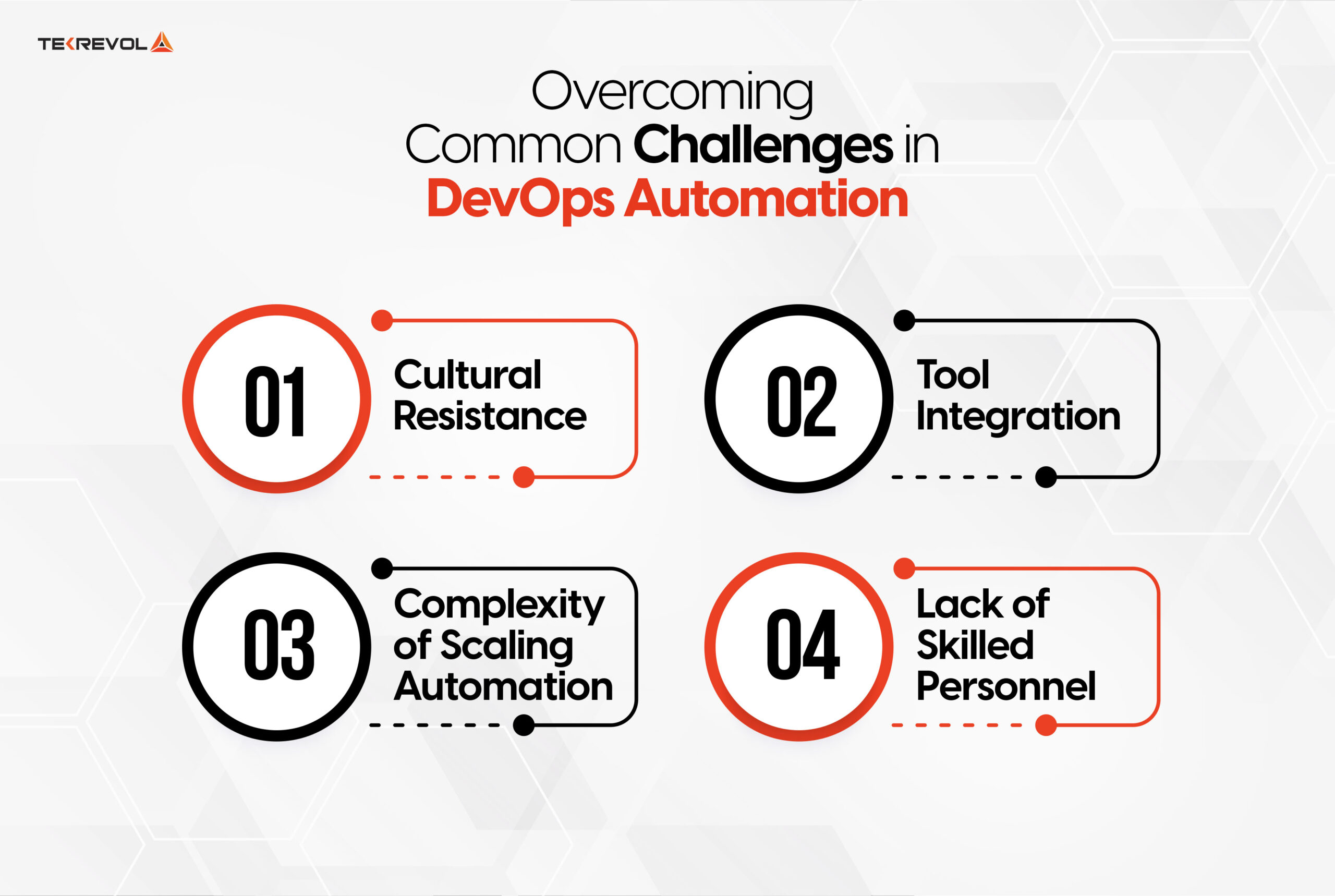
Cultural Resistance
One of the primary challenges is resistance to change. Team members may be hesitant to adopt new tools and processes, fearing disruptions to established workflows. To address this, it’s essential to communicate the benefits of automation clearly.
For example, sharing success stories from similar organizations can illustrate the positive impact of automation. Providing comprehensive training sessions can also ease the transition, helping team members feel more comfortable with new technologies.
Tool Integration
Integrating new automation tools with existing systems can be complex. Organizations should prioritize tools with strong integration capabilities to create a seamless experience.
Instead of overwhelming teams with multiple tools simultaneously, start by automating critical areas and gradually expand the toolset. This phased approach allows teams to adapt without feeling overwhelmed.
Complexity of Scaling Automation
Scaling automation efforts can introduce additional complexity. Aligning DevOps teams towards common automation objectives is crucial. Establishing clear goals and metrics helps ensure everyone is on the same page.
Regular check-ins and collaborative planning sessions can foster alignment and maintain focus on automation goals.
Lack of Skilled Personnel
A shortage of skilled personnel can hinder automation initiatives. Investing in training and upskilling is vital to building the necessary expertise within the team.
Companies can also consider consulting with experts or partnering with organizations specializing in DevOps best practices to bridge skill gaps.
How TekRevol Can Help with Your DevOps Pipeline Automation
Adopting DevOps automation can significantly enhance your organization’s efficiency, reduce release times, and improve software quality. However, many companies face challenges such as cultural resistance and tool integration when implementing these practices. This is where TekRevol comes in.

At TekRevol, we specialize in providing tailored DevOps consultancy services that help businesses streamline their development processes. With a proven track record of delivering successful projects, we empower teams to embrace automation technologies for DevOps effectively.
Our experts leverage the latest tools and best practices to ensure seamless integration and collaboration across your organization.
Choosing a leading mobile app development company in Toronto like TekRevol means partnering with a team that understands the nuances of mobile app development in Toronto. With over 100 successful projects and a client satisfaction rate of 95%, we are committed to driving your success.
Don’t let common challenges hold you back; contact us today to transform your development processes and unlock your full potential!

 544 Views
544 Views January 17, 2025
January 17, 2025

![How to Make an App Like Clubhouse? [Process, Features, Cost and More]](https://d3r5yd0374231.cloudfront.net/images-tek/uploads/2021/10/how-to-make-an-app-like-clubhouse.jpg)
![Mobile App Development Process [Step-by-Step Guide 2025]](https://d3r5yd0374231.cloudfront.net/images-tek/uploads/2023/12/Mobile-App-Development-Process-1.jpg)






